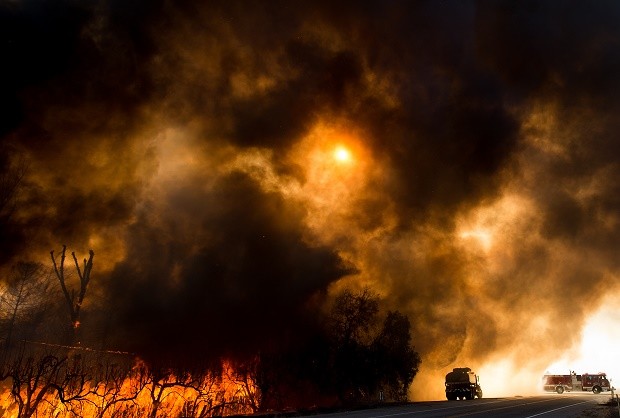Evacuated residents in limbo as wildfire burns in California

Firefighters battle a wildfire as it crosses Cajon Boulevard in Keenbrook, Calif., on Wednesday, Aug. 17, 2016. Firefighters had at least established a foothold of control of the blaze the day after it broke out for unknown reasons in the Cajon Pass near Interstate 15, the vital artery between Los Angeles and Las Vegas. Five years of drought have turned the state’s wildlands into a tinder box, with eight fires currently burning from Shasta County in the far north to Camp Pendleton just north of San Diego. AP
SAN BERNARDINO, California – Twisted metal gates and rusted mailboxes remained where houses once stood. Flames had turned a lot full of cars – including some vintage models – into a junkyard of hollowed-out shells. Countless trees were scorched or gone.
Scenes of destruction were everywhere Thursday after a huge wildfire sped through mountains and high desert 60 miles east of Los Angeles so swiftly that it took seasoned firefighters off guard.
But the day also brought the biggest gains yet against the blaze, with containment jumping from 22 percent, up from just 4 percent when the day began. The fire has burned 56 square miles.
An aerial flyover revealed significant property loss, but crews were just beginning to comb through the rubble to document the devastation.
“Most of the areas where there was structural damage, they’re still smoldering,” US Forest Service spokesman Jake Rodriguez said.
Many residents remained in limbo, unable to go home and wondering whether anything would be left when they can.
“I want it to be over, but more than anything I just want to know, ‘Is my house still there?’ “Lisa Gregory said as she sat in a lawn chair under a tree at an evacuation center.
At its height, more than 34,000 homes and about 82,000 residents were under evacuation warnings.
READ: More than 82,000 people flee Southern California wildfire
While the east side of the fire near the desert was brought partly under control and some evacuees on that side were allowed to return home, the west side’s hillsides were still showing heavy flames and thick smoke.
Meanwhile, a new fire broke out in rural Santa Barbara County, quickly surging to about 500 acres and prompting the evacuation of a pair of campgrounds.
Another blaze near Lake Isabella in Kern and Tulare counties in the center of the state had burned more than two square miles.
During five years of drought, California’s wildlands have seen a continuous streak of destructive and sometimes deadly fires. No deaths have been reported in the latest fire, but crews assessing property damage were using cadaver dogs during searches.
The dry vegetation is like firewood, said fire information officer Sean Collins.
“It burns that much quicker, that much hotter. The rate of travel is extremely fast,” he said.
Wildfires across the country in recent years have grown more ferocious and expensive to fight.
Last year’s fire season set a record with more than 15,625 square miles of land charred. It was also the costliest on record with $2.1 billion spent to fight fires from Alaska to Florida.
Experts have blamed several factors including rising temperatures that more quickly dry out forests and vegetation. Decades of aggressively knocking down small fires also have led to the buildup of flammable fuel. On top of that, more people are moving into fire-prone regions, complicating firefighting efforts.
In the Southern California fire, air tankers bombarded rugged slopes with fire retardant, and a squadron of helicopters dropped load after load of water to corral flames. On the ground, firefighters and bulldozers worked to protect the ski town of Wrightwood and other areas high in the San Gabriel Mountains.
The fire unleashed its initial fury on a semi-rural landscape dotted with small ranches and homes in Cajon Pass and on the edge of the Mojave Desert before climbing the mountains.
READ: California town decimated by wildfire; 175 homes burn
Travel was returning to normal in the pass – a major corridor for trucking, rail and commuter traffic – after Interstate 15 was fully reopened.
In mountains north of San Francisco, fire crews gained more ground on a wildfire as damage inspectors surveyed the area to determine how many structures were destroyed or damaged.
The 6-square-mile blaze was 55 percent contained after destroying at least 268 structures, including 175 homes and eight businesses, in the working-class community of Lower Lake.
The equipment manager, or “armorer,” of the US Olympic fencing team, was among those who lost their homes. Matthew Porter was in Rio with the medal-winning team when the house burned.
Damin Pashilk is charged with 14 counts of arson in connection with 12 separate fires dating back to July 2015 and one count of attempted arson. The 40-year-old construction worker appeared in court Wednesday, but he did not enter a plea.